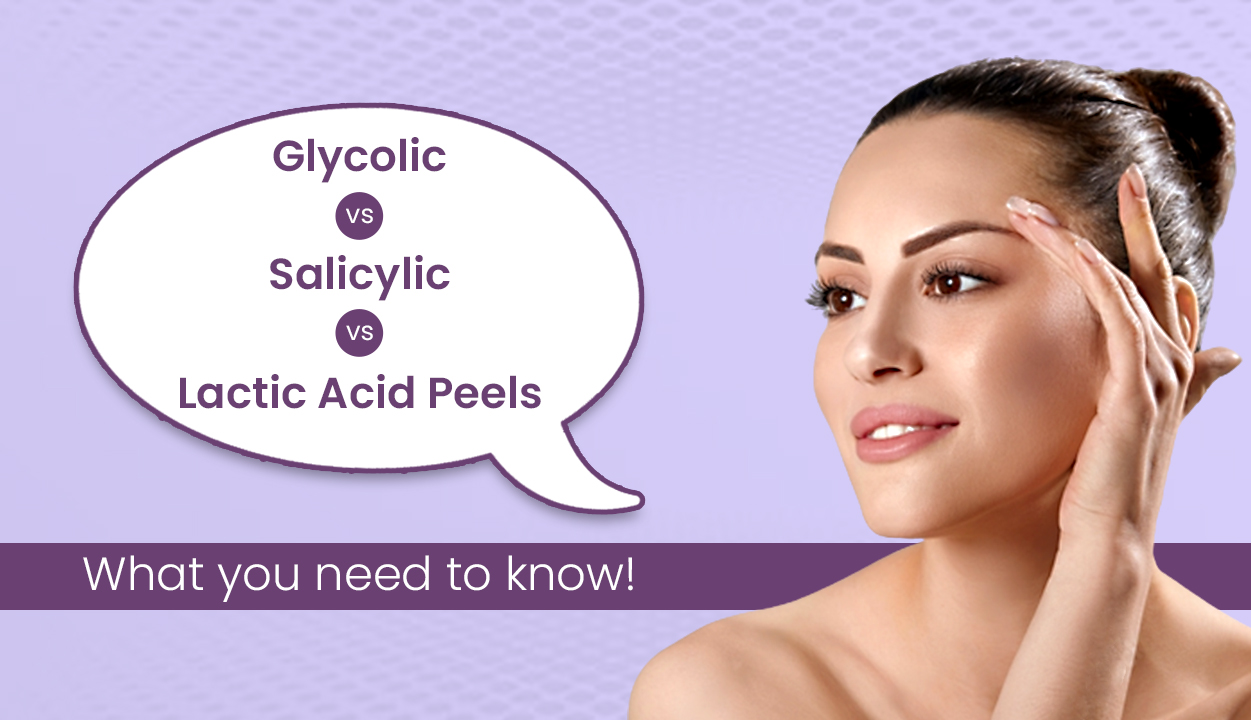
Glycolic vs. Salicylic vs. Lactic Acid Peels: What you need to know!
In the realm of modern skincare, the pursuit of flawless and vibrant skin has led to the emergence of innovative skincare treatments that cater to a spectrum of concerns. Among these, chemical peels have garnered attention as transformative skin exfoliation solutions for acne treatment, fine lines, hyperpigmentation, and more, offering a renewed lease on skin health and radiance. In this comprehensive blog, we delve deep into the world of chemical peels for skin exfoliation, focusing our spotlight on three dynamic players: Glycolic, Salicylic, and Lactic Acid peels. Each of these chemical peels, akin to an artist’s brushstroke, has its unique touch as a skincare treatment, addressing specific skin issues like hyperpigmentation, scars, wrinkles, etc. while unveiling fresh skin beneath.
Glycolic Acid Peels
Glycolic acid, derived from sugarcane, is a natural alpha hydroxy acid (AHA). It is renowned for its small molecular size; thus, it penetrates deeply into the skin.
Suitability: Glycolic acid peels are generally suitable for most skin types, especially those seeking improved texture, mild exfoliation, and a reduction in fine lines and wrinkles. They work well for individuals with normal to dry skin.
Problems Addressed:
- Skin Texture: Glycolic acid peels effectively exfoliate the skin’s outermost layer, resulting in a smoother and softer skin texture.
- Hyperpigmentation: By encouraging cell turnover, Glycolic acid makes the skin tone more even and reduces dark spots.
- Fine Lines and Wrinkles: The peel’s exfoliating properties diminish the visibility of fine lines and wrinkles, promoting a more youthful appearance.
Salicylic Acid Peels
Salicylic acid is a beta hydroxy acid (BHA) that is oil-soluble, making it ideal for penetrating oily skin and clogged pores.
Suitability: Salicylic acid peels are especially suitable for individuals with oily or acne-prone skin. They can also benefit those with combination skin seeking to address acne-related concerns.
Problems Addressed:
- Acne Treatment: Salicylic acid peels make for an effective acne treatment. They deeply penetrate pores, effectively unclogging them and reducing acne breakouts.
- Oil Control: The peel’s ability to regulate sebum production helps control excessive oiliness, minimizing shine.
- Skin Exfoliation: Salicylic acid promotes gentle skin exfoliation, revealing fresher skin and improving overall complexion.
Lactic Acid Peels
Lactic acid is again an alpha hydroxy acid (AHA) derived from milk. It is milder than Glycolic acid, making it a great option for sensitive skin.
Suitability: Lactic acid peels are well-suited for individuals with sensitive or dry skin. They are also recommended for those seeking a gentler exfoliation.
Problems Addressed:
- Hydration and Moisture: Lactic acid peels offer mild exfoliation while simultaneously moisturizing the skin, making them ideal for addressing dryness and promoting hydration.
- Hyperpigmentation: Lactic acid targets hyperpigmentation by breaking down melanin clusters, revealing a more even and radiant complexion.
- Uneven Skin Tone: The peel helps improve skin texture and tone, making it an excellent choice for achieving a smoother and more uniform appearance.
Customizing Your Peel Experience
When considering a chemical peel as a skincare treatment, it’s essential to consult a dermatologist to determine the most suitable option for your unique skin type and concerns. They can tailor the peel’s concentration and frequency for an effective skincare treatment suited to your skin’s needs and ensure optimal results.
Chemical peels offer a world of possibilities when it comes to achieving healthier and more vibrant skin. By understanding the distinctive properties of Glycolic, Salicylic, and Lactic Acid peels and addressing specific skin concerns, you can embark on a journey toward a customized skincare treatment that unlocks your skin’s natural radiance.
